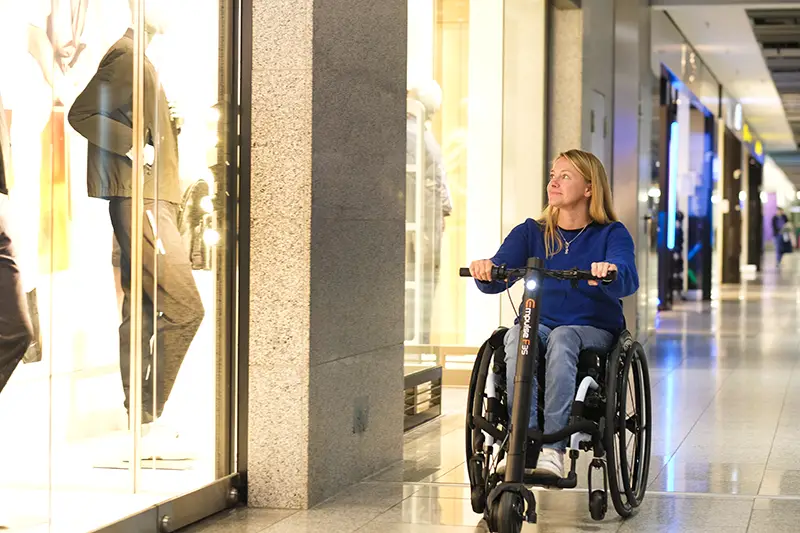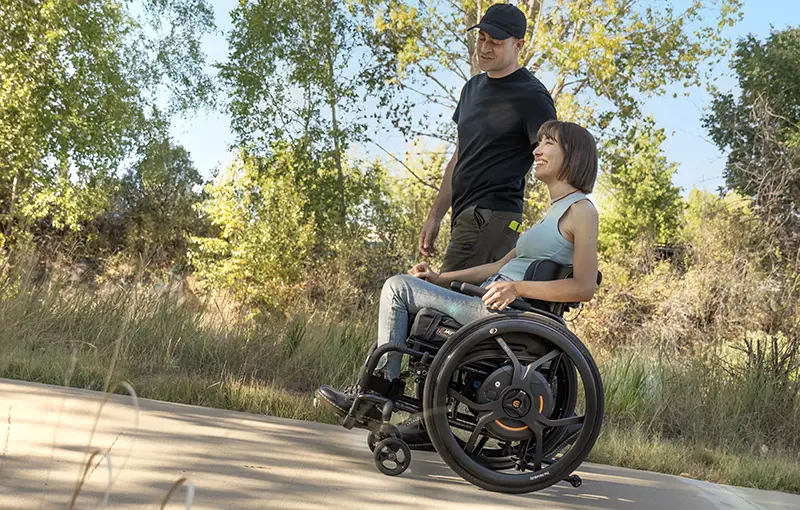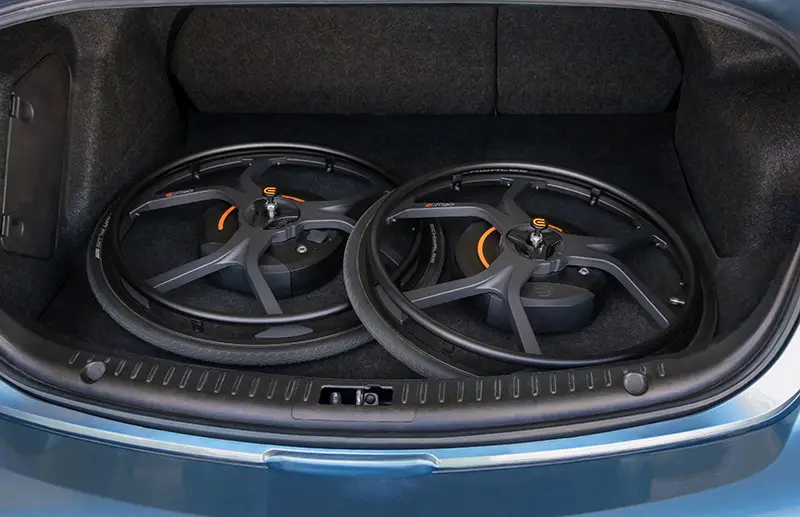How do I start?
Choosing a power-assist device can feel overwhelming at first, but breaking the process into a few clear steps can make it much easier – and more empowering. Here's how to get started:
- Evaluate your environment. Consider where you'll be using the device most often. Will it be indoors, in urban areas, or over rugged or challenging terrain? Look for a model that matches your daily environment in terms of maneuverability, speed, range, and torque.
- Consider your physical strength and skills. Reflect on your upper body strength, hand function, and wheelchair skills. These factors will affect how you interact with the device. Choose one that suits your physical capabilities and offers manageable weight & portability.
- Check compatibility with your wheelchair. Not every device fits every wheelchair. Confirm that the power-assist option you're considering is compatible with your current wheelchair model and frame to ensure safe and effective use.
- Try before you decide. Whenever possible, test out different devices. Hands-on experience is the best way to find out what feels natural and comfortable for your daily needs.
- Consult a professional. A mobility specialist or clinician can help you make an informed choice by offering personalized guidance based on your lifestyle, clinical condition, and preferences.
Selecting the best power-assist device can greatly enhance your mobility, independence, and daily comfort. Here are some key considerations to help you make an informed decision:
Who will drive the power-assist device?
For user-controlled power assist devices, there are three categories:
- Push devices: A unit is clamped onto the wheelchair frame (at the rear) and "pushes" the manual wheelchair forward, like the Empulse R90.
- Wheel add-ons: Normal wheels are replaced with powered wheels where motors are incorporated, providing forward propulsion, like in the Empulse M90 and Quickie Xtender.
- Pull devices: A front wheel assembly is attached to the front frame of the wheelchair and a motorized wheel provides the power. Handlebars allow the rider to steer and control the speed, as seen in the Empulse F35.
For caregiver-assisted propulsion, a powered wheel is attached to the wheelchair, generally to the rear, like the Empulse R20. These devices are designed for users who are dependent on caregivers for mobility. They are controlled by an attendant-operated thumb throttle. Caregiver push devices can also play an important role in preserving the caregiver's health by reducing the physical strain of pushing the wheelchair and its user.

Evaluate Your Lifestyle Needs
Use Environment
Think about where you'll use the device most frequently – indoors, outdoors, on flat or rough terrains, or for short or longer distances. Choose a device that aligns with your typical activities.
For indoor use (shopping malls, houses, offices, etc.), it is important to consider the device's maneuverability and control indoors:
- Maneuverability is better when the device does not increase the overall wheelchair dimensions (footprint), like with the R90, M90, and the Xtender. Pull devices increase wheelchair footprint, making it more difficult to maneuver indoors. Compact models like the F35 would be recommended.
- Control indoors is easier with wheel add-on models that offer power wheelchair-style control – such as the M90 with the all-way toggle. With push devices like the R90 and the wheel add-ons steered with the handrims, the rider will need to pay attention and monitor speed in busier environments. Good wheelchair skills would be recommended. For pull devices, control is easy via the handlebar, but the increase in size may compromise maneuverability. Compact models like the F35 would be recommended for indoor use.
For urban environments (paved surfaces, sidewalks, curb cuts, etc.):
- Push devices (R90) and wheel add-ons (M90 and Xtender) are good for urban environments, being best suited to harder ground and pavement. They could lose traction on soft surfaces like grass and dirt.
- Pull devices (F35) are great for all outdoor activities. The models with smaller front wheels will enhance maneuverability and access to small spaces such as elevators.
For off-road and challenging terrains (uneven terrain, larger slopes, etc.), pull devices like the F55 and StreetJet are great, as they can have substantial speed and torque. Models with larger wheels will cope better with uneven terrains and can travel longer distances.

Range and Battery Life
Consider how far you typically travel on a single outing. Opt for a power-assist device with a range that can support your routine without frequent recharging. Some models like the R90 and M90 have a removeable battery and offer an optional second battery to go even further.
If you want to travel longer distances, pull devices tend to offer larger batteries. The StreetJet can have up to a 31-mile range.
Consider Your Clinical Needs
Do you have impaired upper limb or hand function? If the upper limb strength or hand function is impaired, it is important to consider the device's weight and how it is controlled.
- Wheel add-ons with power wheelchair-style control (like the M90 with all-way toggle) could work well for users with impaired upper limb or hand function. For wheel add-ons that are steered via the handrim such as the Xtender and the M90 in the speed controller with handrim drive mode, the user needs sufficient strength and hand function to steer and brake using the handrims.
- Push devices (R90) could work with impaired hand function, but they may be more challenging to control. For the R90, the rider must have appropriate wheelchair skills to steer and stop, as the device does not have electronic brakes.
- Pull devices are usually heavier and could be difficult to control with reduced upper limb or hand function or reduced trunk stability. Some models like StreetJet offer a quad option that can help manage the device with impaired hand function.
Weight and Portability
If you have reduced upper limb strength or travel often, a lightweight and easily transportable device can make a big difference.
- Push devices (R90, R20) are the lightest and smallest. They are easy to manage and transport.
- Wheel add-ons can be easily transported as they do not add size to the wheelchair, but could be heavy for users with less strength if they need to remove the wheels. The M90 is the lightest in its class.
- Pull devices tend to be heavier and bulkier, thus more difficult to transport. The F35 is the lightest and most compact pull device, and it would be the easiest to transport with reduced strength.

Consider How the Device Is Controlled
Choose one that feels intuitive and suits your physical abilities.
- Pull devices: (F35) Controlled via the handlebar throttle. Speed and direction are easy to manage, but the user should have enough strength, upper limb control, and hand function to handle the device and steer with the handlebar.
- Push devices for independent propulsion: With the R90, the speed is controlled with a wireless control box, and the chair is steered with the handrims. The user should have good wheelchair skills and be able to steer and stop the chair with the handrims.
- Push devices for assisted propulsion: The R20 is controlled by an attendant thumb throttle with an easy on/off button for safe handling and easy operation.
- Wheel add-ons: (M90, Xtender) With the M90, riders can switch between the all-way toggle for power wheelchair-style control, or the speed controller with handrim steering for push-button propulsion and steering via the handrims. The M90 with all-way toggle is a good option for users who lack endurance, strength, or hand control and would benefit from fully controlling the wheelchair with the all-way toggle. With the Xtender, speed and direction are controlled with the handrims. For both the M90 in the speed controller with handrims drive mode and the Xtender, the user should have good wheelchair skills and enough hand function to both steer and stop the wheelchair with the handrims.
Check Wheelchair Compatibility
Ensure the power-assist device is compatible with your wheelchair model and size. Each type of power-assist device has its own way of attaching to the wheelchair and may not be compatible with certain wheelchair frames for safety reasons.
Always consult with a healthcare professional or mobility specialist for personalized advice.
| |
F35 |
R90 |
R20 |
M90 |
Xtender |
| Device Type |
Pull device |
Push device |
Caregiver assist |
Wheel add-on |
Wheel add-on |
| Driving method / Controller |
Handbar throttle |
Speed controller with handrim steering |
Attendant control |
User-selectable dual drive all-way toggle or handrims |
Handrims |
| Use environment |
Urban / Indoor |
Urban / Indoor |
Urban / Indoor |
Urban / Indoor |
Urban / Indoor |
| Range (up to) |
9.3 miles |
9.8-19.5 miles |
9 miles |
9.3 miles |
14-22 miles |
| Weight |
19.8 lbs. |
14.5-15.6 lbs. |
9.9 lbs. |
26 lbs. |
35-37 lbs. |
| Max speed (up to) |
9.3 MPH |
5.5 MPH |
3.1 MPH |
3.7 MPH |
3.7 MPH |
| Wheel size |
6.5" |
7.75" |
6" |
24" |
22" / 24" |
| User's hand function |
Fair to Good |
Fair to Good |
N/A |
Poor to Good |
Fair to Good |